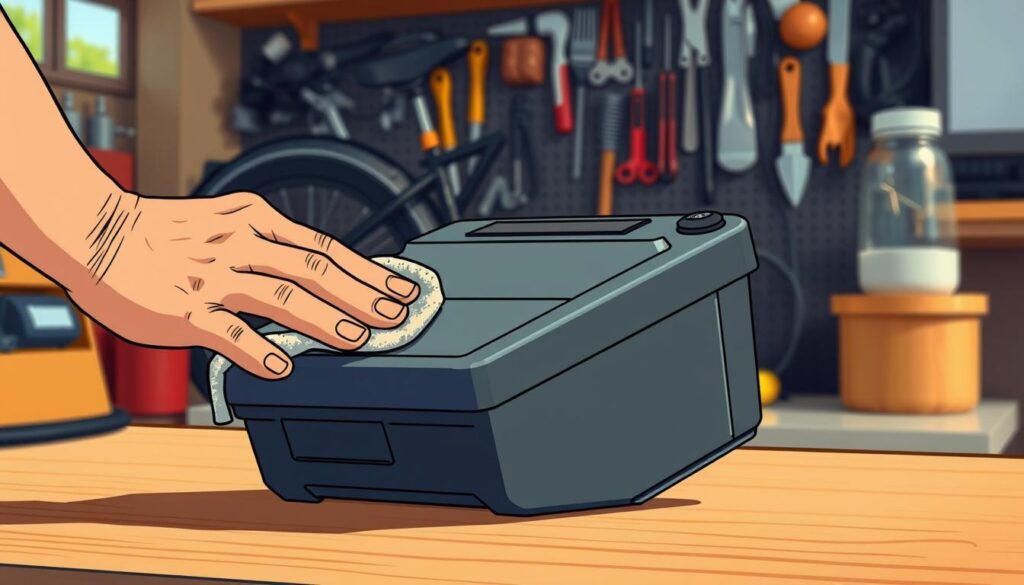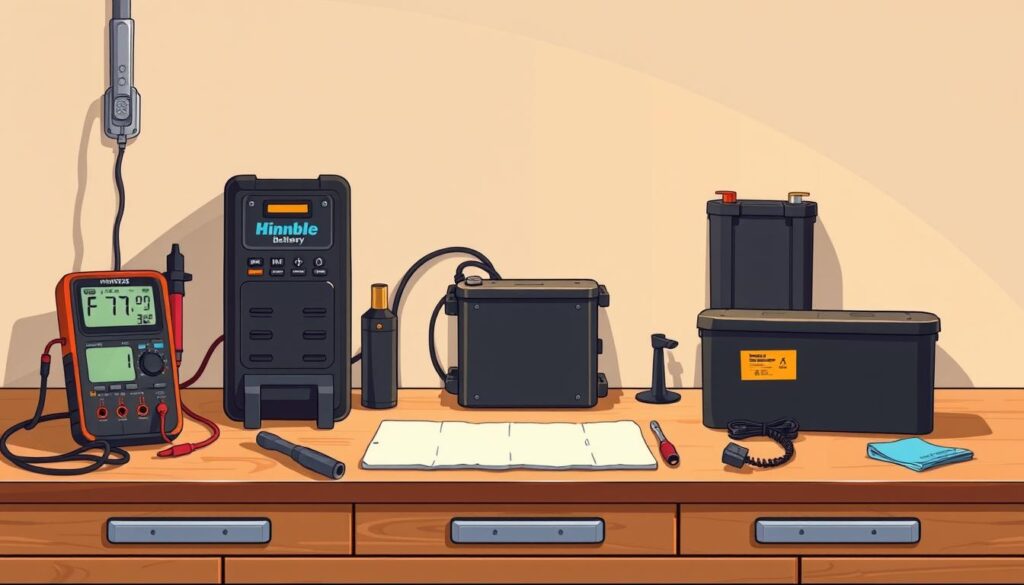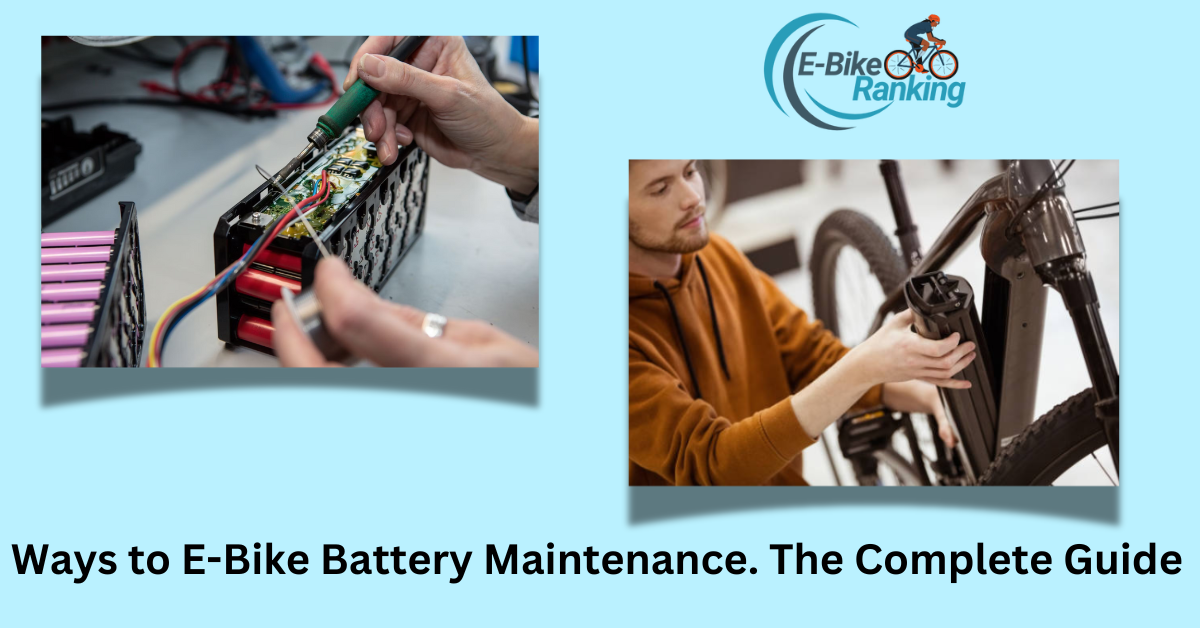As an e-bike owner, knowing how to care for your e-bike battery is key. It helps your battery last longer and work better. A good e-bike battery maintenance routine is vital to avoid damage and cut down on replacement costs.
By using the right e-bike battery maintenance tips, your rides will be smoother and more efficient. This guide will cover all you need to know about e-bike battery maintenance and care. It’s perfect for both new and experienced e-bike owners. It will help you keep your e-bike battery in top shape, ensuring it performs well and lasts longer.
Table of Contents
Table of Contents

🔋 Understanding Your E-Bike Battery Basics
To get the most out of your e-bike, knowing your battery basics is key. This knowledge helps in protecting the battery and making it last longer. E-Bike battery maintenance starts with understanding how your battery works.
E-bike batteries vary, each with unique traits. Understanding these basics prepares you to follow e-bike battery tips and maintain your electric bike properly.
Key components to consider include:
- Type of Battery: Different types like lithium-ion or lead-acid have different care needs.
- Capacity: Measured in watt-hours (Wh), this affects range.
- Components: Includes the Battery Management System (BMS), cells, and connectors.
Knowing these factors sets you up for proper e-bike battery maintenance, helping extend its lifespan.
🛠️ Essential E-Bike Battery Care Tips for Longevity
To keep your e-bike battery in great shape, follow proven e-bike battery tips. Avoid exposure to extreme temperatures and always store the battery properly. Aim to charge it between 20% and 80% if storing it for a while.

Top tips include:
- Don’t let the battery run completely flat.
- Store it in a cool, dry place when not in use.
- Update the battery’s firmware if your manufacturer provides it.
- Clean battery contacts regularly to prevent buildup.
These simple e-bike battery maintenance practices can dramatically extend the life and performance of your battery.
⚡ Proper Charging Techniques and Best Practices
One of the most important aspects of e-bike battery is proper charging. Charging your battery the right way prevents long-term damage and keeps your battery healthy.
Best practices for charging:
- Use the original charger that came with your e-bike.
- Avoid overcharging; unplug once fully charged.
- Don’t let the battery drain to 0%.
- Charge indoors at room temperature.
These steps are essential to good e-bike battery maintenance and will help avoid performance issues down the road.
🌡️ Temperature Management and Storage Solutions
Temperature has a major effect on your battery’s health. Whether it’s summer or winter, storing your e-bike properly is a big part of effective e-bike battery maintenance.
Storage Tips:
- Ideal storage charge is between 40% and 60%.
- Store the battery in a dry room between 50°F and 77°F.
- Keep it away from flammable materials or direct sunlight.
Proper e-bike battery maintenance in storage means your battery will be ready when you are—no unexpected issues or performance drops.
🔍 Signs of Battery Degradation and Preventive Measures
Good e-bike battery maintenance involves recognizing early warning signs of battery problems. If your range is decreasing or charging takes longer than usual, it may be time for maintenance or replacement.

What to look out for:
- Battery swelling or overheating.
- Visible cracks or dents.
- Frequent sudden power drops.
Prevention tips:
- Inspect the battery and connectors regularly.
- Keep contacts clean and rust-free.
- Ensure a tight, secure battery fit.
Stay proactive with your e-bike battery maintenance to catch issues before they become bigger problems.
🌦️ Seasonal Care and Weather Protection Strategies
Each season brings new challenges for e-bike battery maintenance. From freezing winter temps to summer heatwaves, protecting your battery year-round is crucial.
Weather tips by season:
- Winter: Store your bike indoors and avoid using the battery in freezing conditions.
- Summer: Avoid direct sunlight and let the battery cool before charging after a hot ride.
- Spring/Autumn: Clean battery contacts and inspect for moisture buildup.
With consistent seasonal e-bike battery maintenance, your battery will perform its best no matter the weather.
🚴‍♀️ Maximizing Battery Performance During Rides
A big part of e-bike battery maintenance is what you do during your ride. How you ride directly impacts your battery’s efficiency and overall lifespan.
Tips for smart riding:
- Use lower power modes on flat terrain.
- Combine pedaling with motor assistance.
- Maintain proper tire pressure and chain cleanliness.
With these riding habits and regular e-bike battery maintenance, you’ll get the most out of every charge and enjoy longer, more efficient rides.
🛡️ Safety Guidelines for Battery Handling and Maintenance
Safety is a key part of e-bike battery maintenance. Batteries are powerful energy sources, and mishandling them can lead to injury or damage.
Important safety guidelines:
- Always turn off the battery before removing or servicing.
- Wear gloves and eye protection during handling.
- Avoid water exposure and never open the battery casing.
- Follow the manufacturer’s instructions at all times.
Sticking to these rules ensures your e-bike battery is both effective and safe.
âś… Conclusion: Ensuring Long-Term Battery Health and Performance
E-Bike battery maintenance is not just about making your battery last—it’s about getting the most enjoyment from every ride. With proper care, safe handling, and attention to seasonal changes, your battery will serve you reliably for years.
Make e-bike battery maintenance part of your regular routine, and you’ll ride farther, safer, and with fewer interruptions. Keep learning, stay safe, and enjoy the ride!
âť“FAQ: E-Bike Battery Maintenance
Q1: What are the most important factors to consider when maintaining my e-bike battery?
A: Avoid extreme temperatures, charge it between 20–80%, clean battery contacts, and secure it properly to your bike.
Q2: How often should I charge my e-bike battery?
A: After every ride or when it drops to 20–30%. Avoid letting it drop to 0%, and don’t leave it plugged in too long after it’s full.
Q3: What is the optimal temperature range for charging my e-bike battery?
A: Between 50°F and 90°F (10°C to 32°C). Avoid charging in freezing or very hot conditions.
Q4: How can I tell if my e-bike battery is degrading?
A: Look for shorter range, longer charge times, or visible damage like cracks or swelling.








